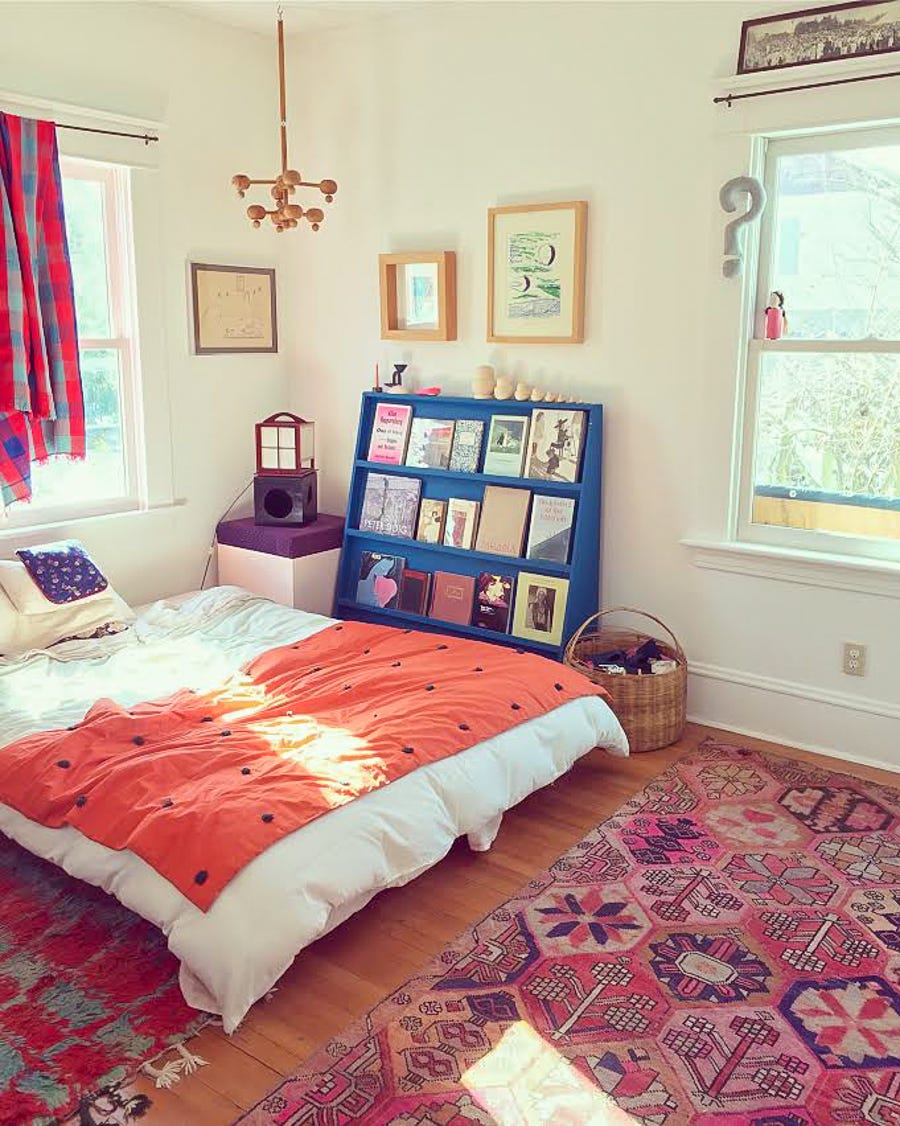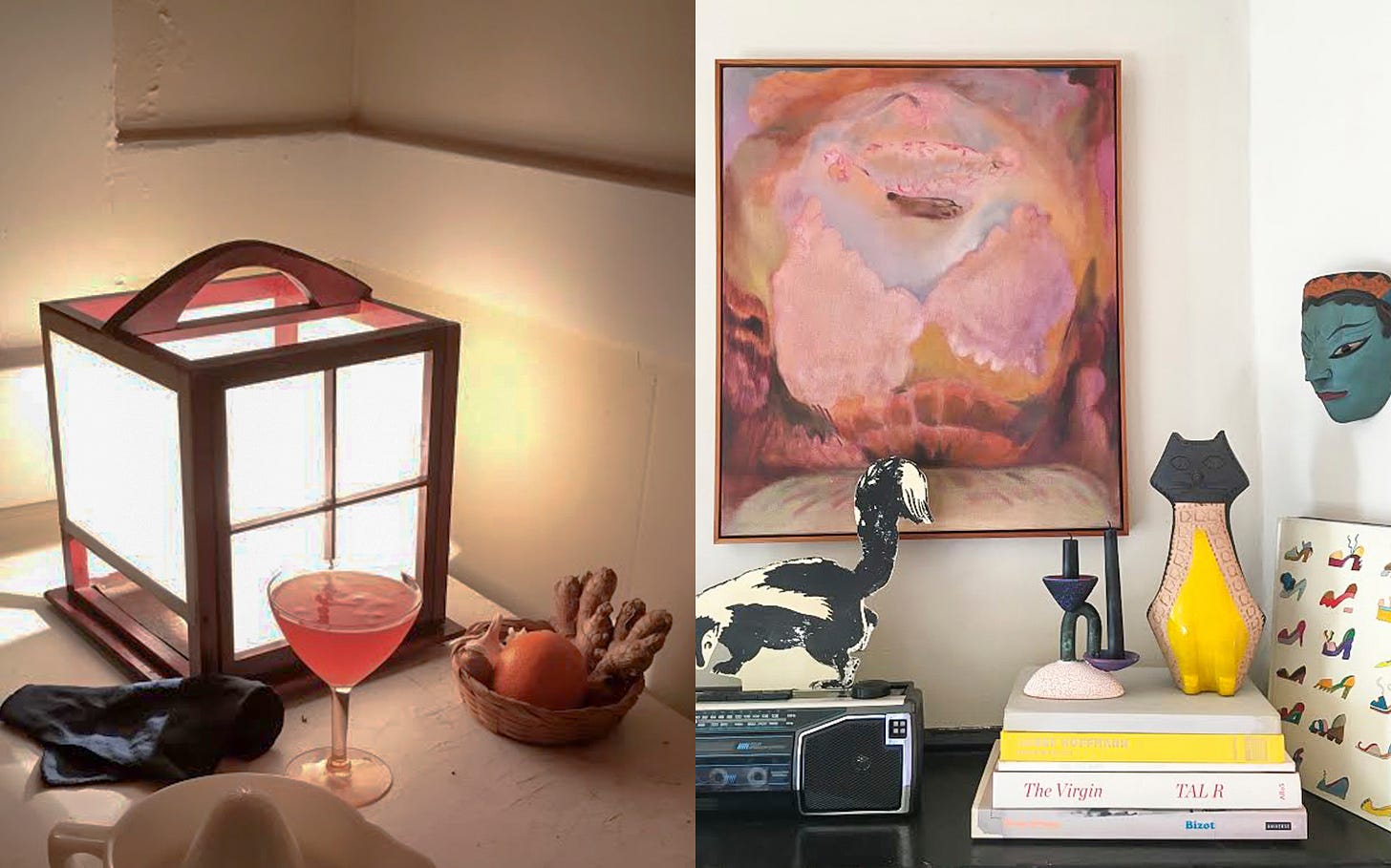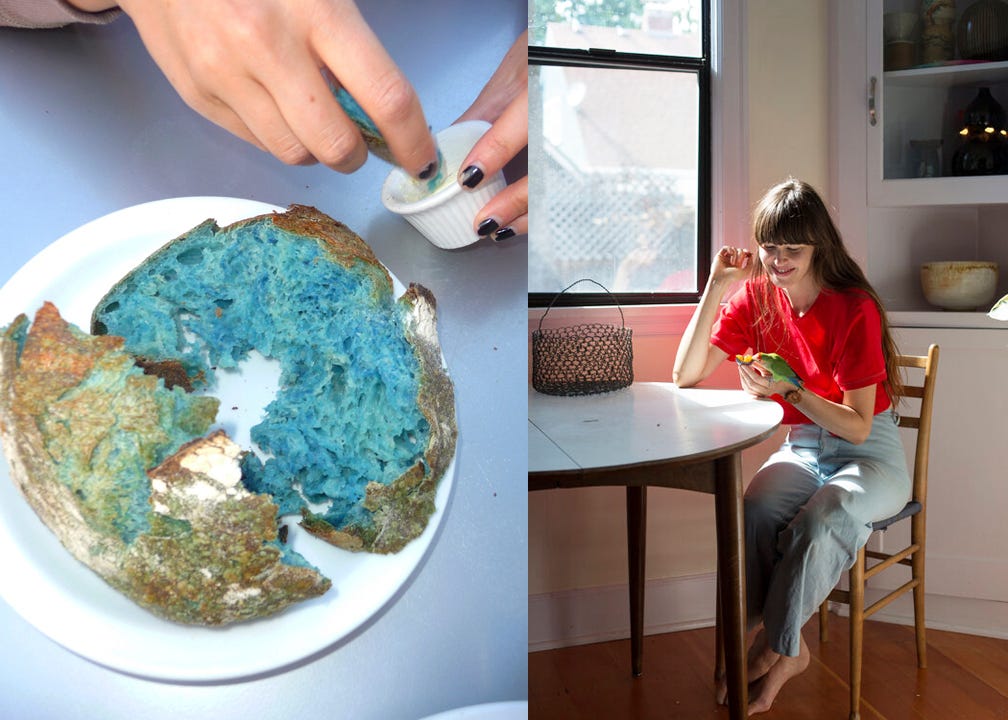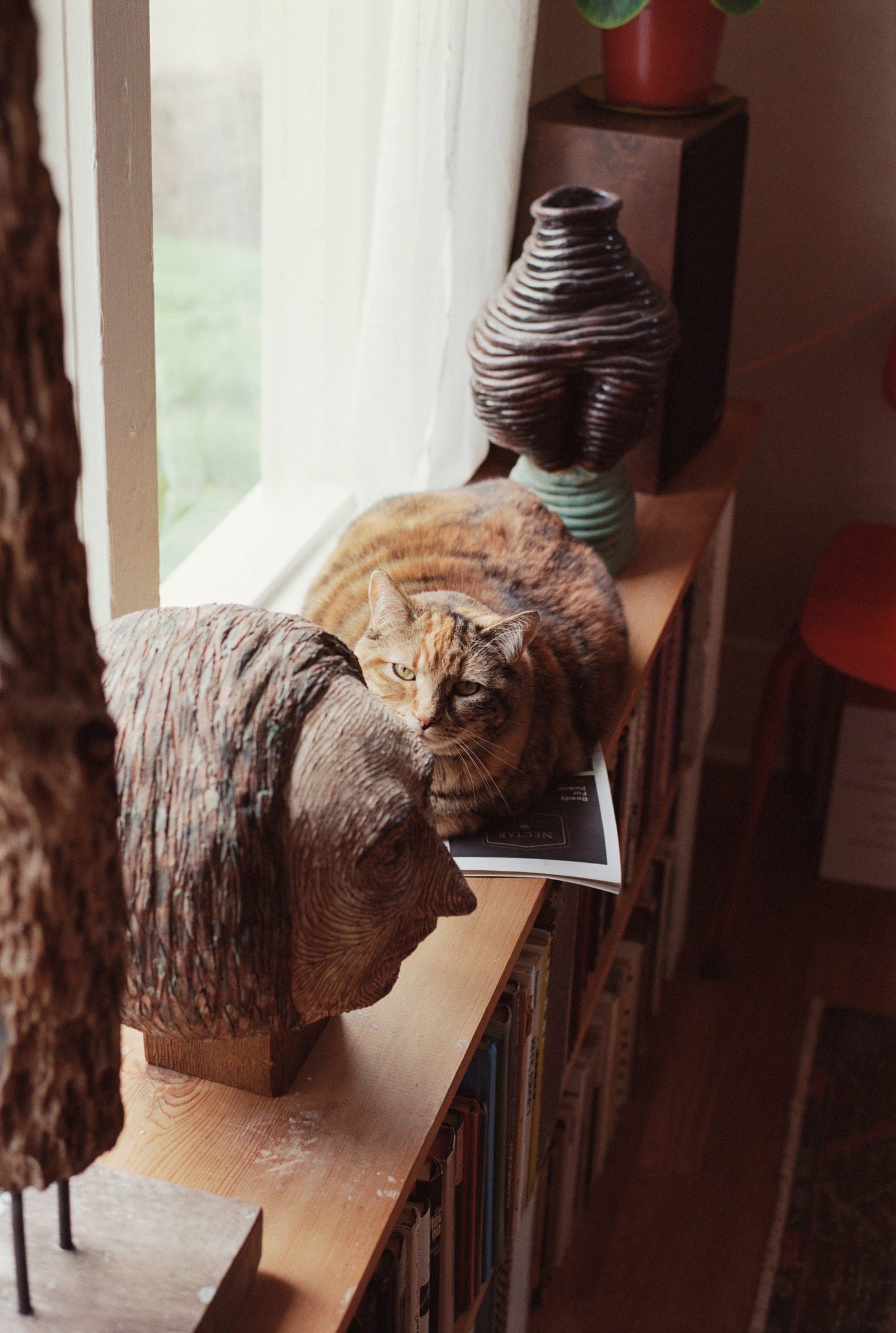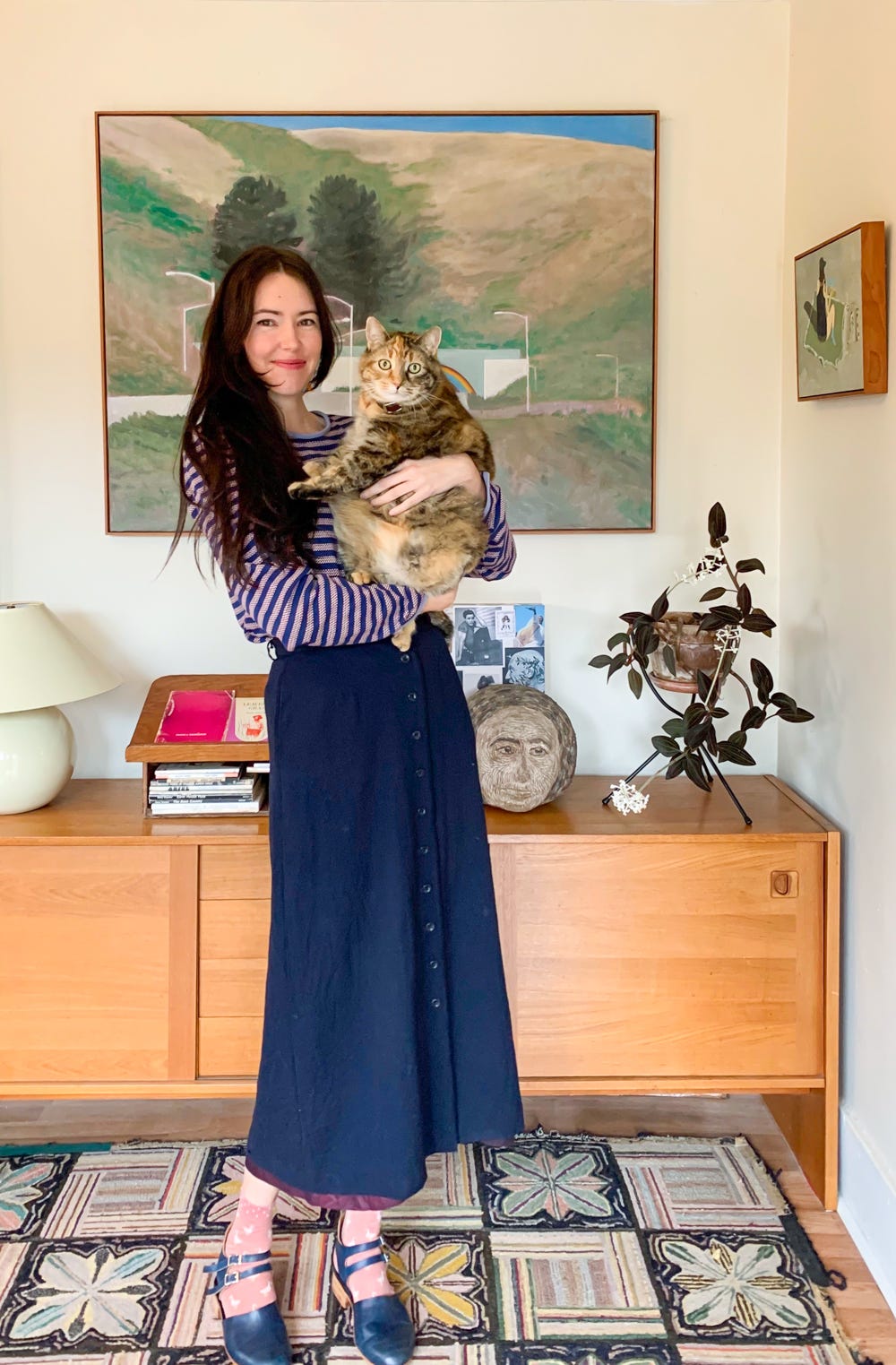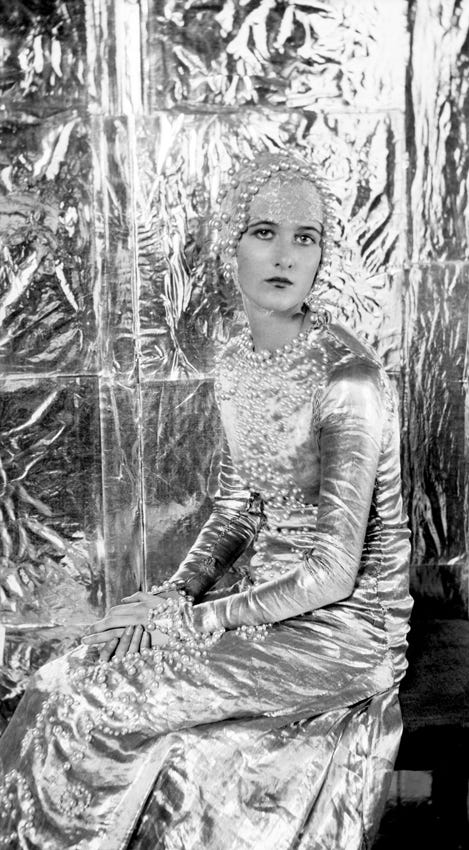At home in Portland, Oregon with Rachel Corry
"I want to be in a space that feels like a mixture of the future and the past."
Good morning.
This month’s REALM features the effervescent artist and sandal-maker Rachel Corry. Rachel is expert at transforming humble materials of ordinary origins into highly covetable, delectable footwear. Sandal design, however, is a single hue in her prism of talents. Years ago, Rachel and I lived together in San Francisco and she similarly transformed rooms in our apartment with easy enthusiasm and intrinsic artistry, making minor additions and adjustments within an afternoon, and without spending a penny. Maintaining balance between familiarity and surprise, Rachel does not treat her domestic interiors like static spaces that eventually “need” updating. Instead, she treats rooms as places of constant potentiality, where furnishings, art and objects mingle as if they were attendees at an ongoing cocktail party, changing places to spend time wherever the conversation between them is most compelling.
I find it remarkable and admirable when an interior is not “designed” but repeatedly enlivened like this. Home offers us space to play with objects and their histories. Any objects that do not reinforce curiosity do not stay at Rachel’s party long. Whether painting dice-like dots onto pillowy marshmallows to serve at dinner, or lassoing clunky, all-white objects together with string to dangle as an oversized mobile in a stairwell, or dyeing her bread dough blue, Rachel’s domestic realm is one of discovery and delight, rooted in artful upside-downing, a kind of object-play.
I wasn’t able to travel to photograph Rachel’s Portland home in person (for all kinds of present-day reasons you can imagine) so I asked her to take a few pictures of her abode and some beloved items within it. I did include an older portrait I took of Rachel with her pet bird Barbie, as well as a snapshot of her blue-hued country loaf. Rachel never frets or complains about her cold, damp surroundings—instead, like her Pacific Northwestern home, she grows cozier, more deliberate and joyful, while always emerging intact, soft and sophisticated—part earth, part cloud. She, and her luminous spaces, are quite a dream.
Airyka Rockefeller: Hello! What’s your home-aesthetic in three phrases?
Rachel Corry: Technicolor objects; tight patterns; lots of low lights.
In the fifteen years I’ve known you, you’ve always been an expert collector of unusual, handmade, older objects. You seem to gravitate toward items that have a splash of surrealism, like the stuffed, sculptural question mark that hangs from your bedroom wall. I often wonder what your lovers think when they look up from your bed and see their own thoughts in the form of questions.
Lovers! Beds! This is getting quite personal. I do love things that are made of the “wrong” material: a wooden telephone, a ceramic head, a dice jewelry box, another dice that holds my sugar. I like these simple surprises. I also collect paper ephemera, art, apples, Snow White books, folk shoes, costume clothes, and Japanese antiques. I have to keep an eye on these collections though; I don't want them to keep growing. My house is sort of small so a few too many ‘cool objects’ can quickly feel like clutter. In fact they’re encroaching on me right now… Sadly, there’s just not enough space!
What’s your version of “domestic bliss”?
Domestic bliss for me would be the realization of the original goals of Sea Ranch—a few dozen acres shared by a dozen or more friends and neighbors. We'd each have our own modest homes and private space, but share a garden, tool shed, and a fantastic bathing space. If I can't achieve this in my lifetime, I’ll be disappointed.
Do you have any rituals around bathing?
I love baths. The moment of submerging into perfect-temperature water (100 degrees) is one of life’s best offerings. In the bath I read a book or magazine by candlelight, and try to stay off my phone. I'm not above eating in the bath. But I can't tell—is that decadent, gross, or fun? A shower is a totally different experience because you can't “do” things in the shower: it’s incidental meditation time. Being a little stoned while bathing is best.
I remember watching a Rohmer film you recommended, Full Moon in Paris, and completely falling in love with it and its interiors: the main character plays an interior designer—her apartment looks like a painter’s studio—complete with freestanding columns, vases of drugstore flowers, and pale sheets draped over the furniture. Have you ever watched a film and wished you lived inside it?
You recommended Full Moon in Paris to me! But I have a Rohmer for you: The Marquis of O, with Bruno Ganz (my crush)—it’s as strange and awkward as the book it’s based on. If I could live in a film though, I would choose Uncle Yanco by Agnès Varda. Her uncle lives a bohemian life as a painter on an old barge in Sausalito, surrounded by his friends and colorful collections. I was lucky a few years ago and actually got to spend a few nights on that same boat. It’s a sometimes-artist residency and still completely infused with magic. Alan Watts died there; I felt friendly-ghost feelings in the downstairs hall.
What’s your most beloved object at home and how did it enter your life?
A Japanese box lamp: it’s a wooden box painted with black enamel, with panels of rice paper and subtle shapes of the moon carved into each side, and a handle at the top. I got it in an antique shop in San Francisco’s Japantown underground mall. The dealer told me it was pre-1900—before it was wired for light-bulbs, it was used to carry around candles. So it was a light-briefcase! The light it casts is so calming. It's a treasure.
What do you think homes of the future will be like?
I hope that we can apply what we know about passive energy collection, sustainable materials, and smart land use. I'd love to see streets and cars sidelined, and have meadows and gardens connect homes with space for creatures to travel around. We should work with whole materials and cleverness: a mix of space, coziness and beautiful light. While we’re on the subject of improved environments—moving furniture feels wrong. It should stay with a home, don’t you think?
I suppose that’s the premise behind the built-in. The Victorians were certainly fond of those. Your idea that furniture should belong to a house more than to an individual, seems aligned with your interest in designed communities, where collaboration and shared resources are more useful and meaningful than individual ownership. What or who else influences your home-aesthetic?
So many: Josef Hoffmann & Wiener Werkstätte, Rudolph Schindler, Bauhaus, Japanese Folk art, Surrealism, ‘60s back-to-the-land movements. I want to be in a space that feels like a mixture of the future and the past. Hoffmann designed an art gallery in 1908 that I'm still so impressed by. When I owned a shop, I mimicked the way he painted the corner moulding to emphasize the cube-ish-ness. I think it's such a good idea.

I really love the way you display books with their covers facing outward. You use a tilted shelf you found on the street, then painted bright blue—we had similar shelves in our elementary school library, actually! I love how you layer multiple books in an ever-changing display. How do you organize your book collection?
I don't really know what to do with large art books; they're in stacks on the floor, above the fireplace, leaning against walls. I would love better shelving, but I’m a renter and the walls are made of powder. I recently started grouping some of my favorite authors: Robert Walser, Jane Bowles, Knut Hamsun, Jean Rhys. Makes it feel more like a library. I also made a poetry shelf and put it in an accessible spot. Because poetry is something I take in small doses, it benefits from being in a high traffic area.
Do you think style can be taught? How did you nurture or develop your style?
Style has a lot to do with privilege and access, but there are work-arounds, and it can be very personal. I think by playing favorites (through what you collect, read, wear, watch) you develop your own little vocabulary of joy, your world of imagery to draw from. It can feel fun to build for yourself, and quite powerful. It's flattering when your friends start to recognize something that is “your style,” but it can become a burden. My friend Maggie once said her favorite animal was a hippo, and was doomed to a lifetime of hippo-gifts.
What do you consider the most meaningful thing about where you live that you wouldn’t be able to take with you, if you relocated?
Our house sits on a hill on a corner lot. We have a yard on three sides, completely made of weeds. Because our house is elevated, there's a nice sense of privacy. My 2 housemates and I can sit in the front yard, have a picnic, and wave down to the passers-by. We wouldn’t have nearly as many picnics if we had a flat-on-the-sidewalk front yard. This has been really fortunate in a year when private-space and picnics are so important for social visits.
If you could make your bedroom look like a work by one of your favorite painters, whose would it be?
Léonard Tsuguharu Foujita or Edouard Vulliard
What is your most pressing concern about our collective home, the planet we share?
I'm most concerned by the loss of so many species and wild places. It’s an immense tragedy that I cannot come to terms with. So many life forms are in a state of vulnerability or collapse. We haven't even bothered to learn their magic, or speak with them. All I manage to do is tithe a small monthly amount to Rainforest Action Network and try to keep my footprint in mind. I obsess over recycling, reuse packaging, and often buy used. I know there’s more I can do. I've been trying to eat more of my meals vegan, which is a start. But I fly, I drive, I use leather. I buy food in plastic. We just need a whole new model—it's difficult to break the mold that’s been set.
What’s your favorite home resource?
I love flea markets, but I haven't been to one in ages. Same with estate sales, my very favorite resource. I can spend a long time on Etsy looking for Italian stovetop espresso-makers, weird table lamps and rag rugs, but I rarely make a purchase.
Describe your home in 5 words.
Colorful, whimsical folk-art shack.
Describe your dream home in 5 words.
Superbly special bathing ritual place.
Pursue more about Rachel Sees Snail Shoes, Rachel’s sandal company, her upcoming book The Sandalmaking Workshop, and her shoe-making kits, deliverable by mail.
Delving Deeper: Developing A Vocabulary of Style
As Rachel puts it: “playing favorites,” or creating a world of imagery to draw from, affects how we live, so consider what you read, watch, wear and collect to be key aspects of your expanding, stylistic vocabulary. Pay attention to what you’re drawn to, to what moves and enlivens you, and find ways to let them resonate within your home.
Style, whether it’s how you decorate your living body or your living space, is cultivated by alert eyes and a curious mind. It is rooted in loving something in the world that compels you—be it in history, botany, textiles, music, geometry, or homemade jam—whatever your jam is. It’s a falsehood that style is intrinsic, passed down, or innate. Unlike a stylish object, style itself emerges via a process of discernment and cultivation. Style is not instantaneous, nor available simply by purchase. It’s a sensual sensibility—one I’d argue should be shared, not cooped up alone.
My friend, the street-portraiture photographer Andrew McKinley, who’s been documenting artists in the Mission neighborhood of San Francisco for three decades, once told me with utmost confidence: “style is a gift for the streets.” I think about this often, especially as the city streets feel so bleak as of late. I live in the Castro in San Francisco and even in winter, there are a few men sauntering about nude, save for tennis shoes and a mask. I’m not sure it’s a gift for the streets, but it’s something.
The documentary film The Times of Bill Cunningham echoes the idea of style as an offering for others, not just something to hone in, alone. The film moves at an astonishing pace through fifty years of Cunningham’s electric, candid photographs of New York City’s uniquely stylish denizens; a smörgåsbord of fashion, a love letter to NYC, and a moving portrait of a man whose life’s work was focused on how those around him composed and comported themselves.
If you’d like another documentary about a stylish eccentric, I recommend The Eye Has To Travel about Diana Vreeland’s life and career. Years before movie theaters went dormant, Rachel and I watched it at The Castro Theater, a palatial movie house near our home. We nearly fell from our balcony seats, so enchanted by Vreeland’s insights, outfits, and way with words. Both her dress and domestic-interior style attest to a ravenous appetite for idiosyncratic beauty. Vreeland is hilarious, poetic, and a bit mad. She even designed her home in New York City (an apartment nearly obliterated with overlapping shades of red and nature-patterns, always teeming with cut flowers) to look “like a garden in hell.” Oh, I adore her.
While you’re riding the documentary wave, with films at your fingertips through the free (public library) app Kanopy, you should also watch Cecil Beaton’s Love, Cecil. Beaton, most famously known as a photographer of artists from the 1920’s-1940’s, definitely inspired by the Surrealist artists of his era. Beaton translated his particular aesthetic into costume, lighting, film and stage design, as well as photography and sculpture. His fondness for covering walls with luminescent aluminum foil even inspired the decor of Warhol’s Studio 54 decades later.
My first year of college, I shellacked the door to my dorm-room in crinkly silver wrappers (the backs of every York Peppermint Patty I could get my sugary hands on). Twenty years later, I wrapped another domestic doorway in foil. Both silver gateways were, though I didn’t realize the direct link at the time, inspired by a century-old photograph—an image Beaton took of his sister, Baba—below, that I ripped from Vogue when I was thirteen. That same, tattered magazine page is still in my life, now framed in silver. Silver or not—whatever it is that makes you glow—pursue it, adore it, and stick with it.
If you appreciate delving into the history of both commonplace and rare things considered beautiful across many decades and places, The Encyclopedia of the Exquisite is a delight, a favorite book, and dare I say, a Valentine’s gift for anyone you love, who loves the history of beautiful or artful things. Among much else, it discusses the evolution of the kimono, the brutal origin of confetti, and how classical ballet positions were invented by one dramatic girl. Entries are just a few pages long, and there’s so much to learn, to inspire you, within it.
If you have, like both Rachel and myself, utopian aspirations for communities rooted in inventive architecture, sustainable ecology and visionary design, I recommend Avery Truffleman’s podcast Nice Try, which features a number of communities around the world who tried not only to define, but to create, perfect places and ideal spaces for living. These attempts at constructing utopias offer hilarity and unexpected lessons, despite imminent failures to truly get there. I’m (re)listening to the whole podcast from scratch: so should you. Avery Truffleman is a force, and one of my favorite thinkers within the podcast realm.
Consider Home
…a realm in which to hone your vocabulary of joy and style. Consider your home-style an evolving, relational, personal vocabulary, a collection of references, juxtapositions, and experiments. Any private, physical space is a true luxury. Be grateful for it daily, and use it as a tangible way to engage with what inspires you.
Etymology Interlude:
Spruce: sproos (adjective). Neat; smart in dress and appearance.
Late 14th century: derived from Middle English Pruce, short for Prussia.
An alteration of Pruce, or Prussia, an erstwhile German region considered a land of luxuries by the English because of its luscious farmland, ample cattle, and fashionable leather.
Spruce leather was made into a vest-like jacket so coveted by the English that associations between fashion and Prussia/Pruce/Spruce became deeply lodged. Eventually, the word spruce came to describe anyone dapper and stylish. Later, spruce was also used as a verb; to spruce up means to tidy or beautify oneself, a room, or a place.
The Spruce tree hails from the Prussian region as well, along the Baltic Sea, but was given its moniker a few hundred years after spruce had come to mean dapper, styled, neat, smart or lovely.
For whom do you spruce?
Until next time,
Airyka


